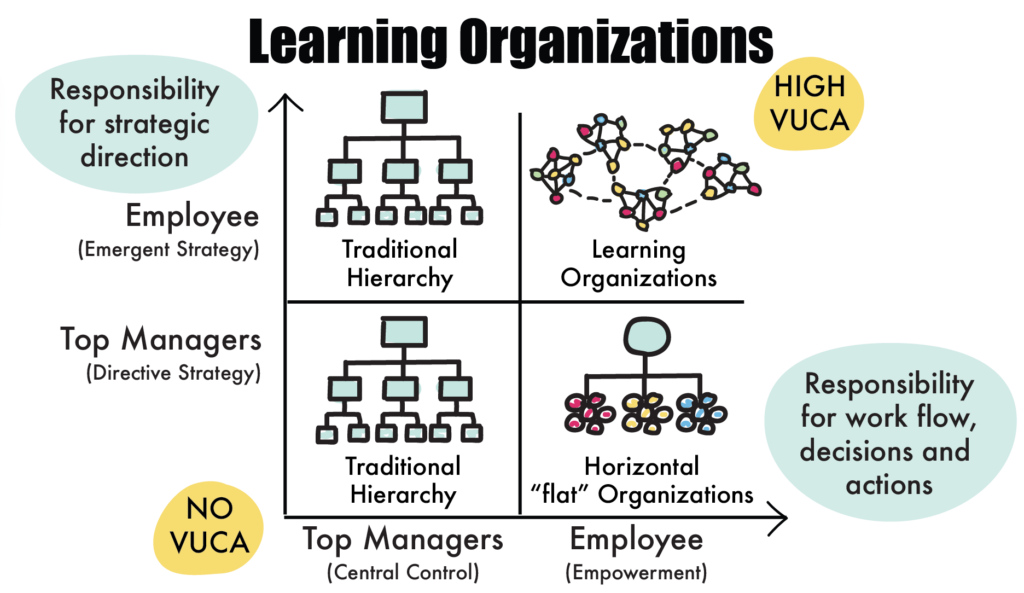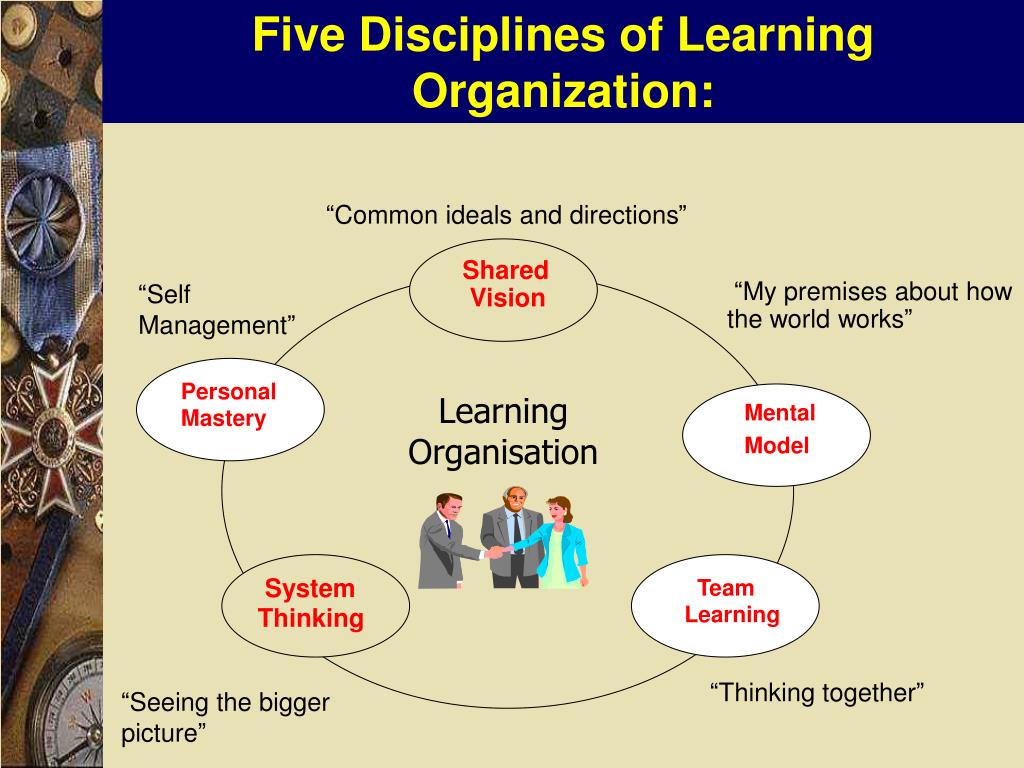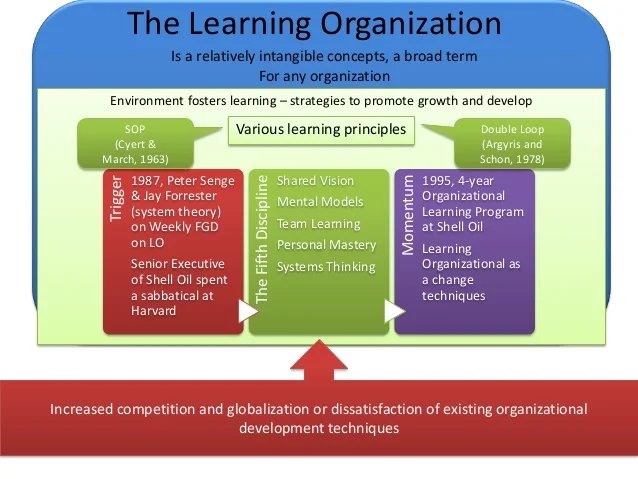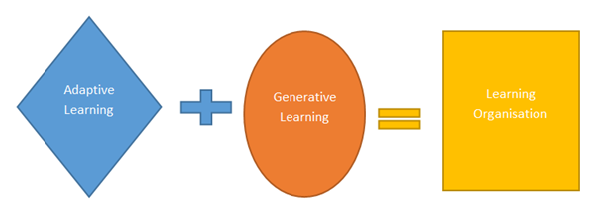Welcome to our blog post on the concept of the Learning Organisation. Organisations must learn and adapt to remain competitive in today’s fast-paced and ever-changing business landscape. The idea of a learning organisation has gained significant attention as a means to achieve this. So, what exactly is a learning organisation, and why is it important? In this post, we will explore the definition, relevance, and benefits of a learning organisation and provide insights on how to get started and sustain it for long-term success. Let’s dive in!

Understanding the Learning Organisation
What is a learning organisation, and why is it important?
A learning organisation is a company that values and promotes continuous learning and development among its employees. It fosters a learning, innovation, and improvement culture, encouraging individuals to acquire new knowledge and skills to adapt to changing business environments. This concept is crucial because it enables companies to stay competitive, adapt to market trends, and drive growth.
How can a learning organisation contribute to a company’s growth and success?
A learning organisation contributes to a company’s growth and success by enhancing employee skills and knowledge, improving decision-making processes, fostering innovation and creativity, and promoting a collaborative and engaged workforce. Organisations can respond more effectively to challenges and opportunities by continuously learning and adapting, ultimately achieving improved performance and results.
Importance of the Learning Organisation
Adopting the concept of a learning organisation is highly relevant for businesses today. Companies need to adapt and learn to stay competitive continuously in a rapidly changing global economy. Here are some reasons why the learning organisation is essential:
1. Continuous Learning
A learning organisation promotes a culture of continuous learning and development. It encourages employees to seek new knowledge, skills, and experiences, fostering personal and professional growth. This lets individuals stay updated with industry trends, technologies, and best practices.
2. Innovation and Adaptability
A learning organisation is equipped to embrace innovation and adapt to change. Encouraging employees to learn and explore new ideas creates a more agile and flexible workforce. This allows the company to adapt quickly to market shifts, technological advancements, and changing customer needs, leading to increased innovation and competitive advantage.
3. Employee Engagement and Retention
A learning organisation invests in its employees’ growth and development, making them feel valued and engaged. This leads to higher employee satisfaction and retention rates. When employees have opportunities to learn and apply knowledge in their roles, they will likely feel more fulfilled, motivated, and committed to the organisation.
4. Organisational Resilience
Employees are encouraged to learn from failures and setbacks in a learning organisation. They develop resilience and problem-solving skills, enabling them to overcome challenges and adapt to unexpected circumstances. This builds a resilient and agile organisational culture that can navigate disruptions and uncertainties.
5. Knowledge Sharing and Collaboration
A learning organisation promotes knowledge sharing and collaboration among its employees. Creating platforms and processes for sharing expertise and insights breaks down silos and fosters a culture of collaboration. This enhances cross-functional communication, teamwork, and collective learning, improving decision-making and problem-solving.
The learning organisation is essential for businesses as it enables continuous learning, fosters innovation and adaptability, enhances employee engagement and retention, builds organisational resilience, and promotes knowledge sharing and collaboration. By embracing the learning organisation concept, companies can position themselves for long-term growth and success in today’s dynamic business environment.

Relevance of the Learning Organisation
The concept of a learning organisation is highly relevant in today’s fast-paced and ever-changing business world. It addresses the challenges companies face in adapting to new technologies, market trends, and customer demands.
By embracing the principles of a learning organisation, businesses can stay agile and competitive in a dynamic environment. Here are some reasons why the concept of a learning organisation is crucial:
1. Continuous Improvement
A learning organisation promotes a culture of continuous improvement. It encourages employees to constantly seek new knowledge, develop skills, and enhance performance. This focus on ongoing learning and development ensures that the company remains at the forefront of its industry.
2. Adaptability
A learning organisation is adaptive and responsive to change. It enables employees to quickly learn and adapt to new technologies, processes, and market conditions. This adaptability is crucial in the face of disruptive industry trends and emerging competitors.
3. Innovation
Learning organisations foster a culture of innovation. Employees are encouraged to explore new ideas, experiment, and take calculated risks. This innovation mindset leads to development of new products, services, and processes, giving the company a competitive edge.
4. Retention of Knowledge
A learning organisation values the preservation and sharing of knowledge. It establishes systems and processes to capture and disseminate valuable knowledge within the company. This ensures that expertise is retained even as employees come and go, preventing the loss of critical knowledge.
5. Employee Engagement and Satisfaction
Employees who work in a learning organisation are more engaged and satisfied. They have opportunities to learn and grow, and their contributions are valued. This leads to higher levels of employee retention, motivation, and productivity.
Examples of successful learning organisations include companies like Google, Amazon, and Netflix. These companies have embedded learning and development into their organisational culture, resulting in continuous innovation, growth, and long-term success.

Getting Started with the Learning Organisation
Implementing a learning organisation requires careful planning and consideration. Here are some initial steps to help you get started:
- Evaluate the current learning culture: Assess your organisation’s existing learning environment and identify improvement areas.
- Set clear objectives: Define the goals and objectives you wish to achieve by implementing a learning organisation. This will guide your strategies and initiatives.
- Create a learning strategy: Develop a comprehensive plan outlining the processes, resources, and tools required to foster a culture of continuous learning.
- Engage leadership: Gain top management’s support and commitment to ensure the learning organisation’s success. Leaders should be champions of learning and actively promote its importance.
- Communicate and involve employees: Communicate the purpose and benefits of the learning organisation to all employees. Encourage their active participation and involvement in the learning process.
- Invest in learning resources: Allocate resources, such as training programs, workshops, and learning materials, to facilitate the development of knowledge and skills within the organisation.
- Facilitate knowledge sharing: Implement platforms and systems that enable employees to share their knowledge and expertise. Encourage collaboration and the exchange of ideas.
- Monitor and evaluate: Establish mechanisms to monitor and evaluate the effectiveness of your learning initiatives. This will allow you to make necessary adjustments and improvements.
Remember, implementing a learning organisation is an ongoing process. It requires continuous effort and commitment from all levels of the organisation, but the rewards for improved performance and growth are worth it.
Key Roles in the Learning Organisation
Within a learning organisation, several vital positions or roles play a crucial role in fostering a culture of learning and development. These roles include:
1. Learning and Development Manager
The learning and development manager is responsible for designing and implementing organisational learning initiatives. They collaborate with various departments to identify training needs, develop programs, and evaluate their effectiveness.
2. Learning Champions
Learning champions are passionate about continuous learning and promoting it within the organisation. They advocate for education and encourage others to engage in learning activities.
3. Subject Matter Experts
Subject matter experts possess deep knowledge and expertise in specific areas. They play a vital role in sharing their knowledge and guiding others. They are often involved in mentoring and coaching employees.
4. Managers and Supervisors
Managers and supervisors are crucial in supporting and encouraging learning within their teams. They allocate time and resources for learning activities, provide feedback and guidance, and create a safe environment for experimentation and learning.
5. Employees
Every employee within the learning organisation is responsible for actively participating and contributing to the learning process. They must proactively seek learning opportunities, share knowledge with colleagues, and apply new skills and expertise in their work.
These key roles work together to create a collaborative learning environment where everyone is encouraged to continuously learn, share knowledge, and contribute to the overall growth and success of the organisation.

Responsibilities in the Learning Organisation
Within a learning organisation, individuals are responsible for contributing to the overall learning and development culture. These responsibilities include:
- Continuous learning: Employees are responsible for actively engaging in ongoing learning opportunities and seeking new knowledge and skills.
- Knowledge sharing: Employees are responsible for sharing their knowledge and expertise with others in the organisation, fostering a collaborative learning environment.
- Feedback and reflection: Individuals should provide constructive feedback and openly reflect on their learning experiences to encourage growth and improvement.
- Mentoring and coaching: Employees can be mentors or coaches to guide and support others in their learning journeys.
- Embracing change: Individuals need to embrace change and be open to new ideas, innovations, and approaches to learning.
- Active participation: Employees should actively participate in training programs, workshops, and other learning initiatives the organisation offers.
- Collaboration: Individuals should actively collaborate with team members and colleagues to enhance learning through shared experiences and knowledge.
- Taking ownership: It is the responsibility of individuals to take ownership of their learning and development, setting goals and seeking resources to achieve them.
By fulfilling these responsibilities, individuals contribute to the overall success of the learning organisation and create a culture of continuous learning and growth.
Implementing the Learning Organisation
Implementing a learning organisation requires careful planning and strategic execution. Here are some best practices and strategies to consider:
1. Develop a clear vision and strategy
Ensure that the learning organisation’s purpose and goals align with the company’s overall objectives. Establish a clear vision and strategy to guide the implementation process.
2. Secure leadership commitment
Obtain buy-in and support from senior leaders within the organisation. Their commitment is essential for creating a learning culture and driving changes.
3. Identify and allocate resources
Determine the financial and human resources needed to support the learning organisation. Allocate budget and designate dedicated employees to oversee and manage learning initiatives.
4. Establish learning mechanisms
Implement various learning mechanisms such as training programs, mentorship opportunities, knowledge-sharing platforms, and continuous improvement processes. Encourage employees to engage in these mechanisms actively.
5. Foster a safe learning environment
Create a supportive and psychologically safe environment where employees feel comfortable taking risks, experimenting, and sharing ideas. Foster a culture that values learning from failures and encourages innovation.
6. Ensure effective communication and collaboration
Facilitate open and transparent communication channels for sharing knowledge and insights across different departments and teams. Encourage cooperation and cross-functional learning to leverage diverse skills and perspectives.
7. Evaluate and adjust
Regularly assess the effectiveness of the learning organisation’s initiatives and make necessary adjustments. Collect feedback from employees and measure the impact of learning on organisational performance.
8. Celebrate achievements
Recognise and celebrate the achievements of individuals and teams who contribute to the learning and development culture of the organisation. Create a positive reinforcement system to encourage continuous learning and improvement.
Note: Implementing a learning organisation is an ongoing process and may require continuous refinement and adaptation to changing circumstances and needs.
Sustaining the Learning Organisation
Once a learning organisation is established, companies must sustain it long-term. Here are some critical considerations in maintaining and nurturing a learning organisation:
1. Leadership Support
Leadership plays a crucial role in sustaining the learning organisation. Top management needs to demonstrate commitment to learning and development initiatives continuously. This can be done through active participation in training programs, empowering employees to learn and grow, and allocating resources for learning initiatives.
2. Continuous Learning Opportunities
A learning organisation thrives on continuous learning opportunities for its employees. Companies should provide a range of learning methods and resources such as training programs, workshops, online courses, mentorship programs, and knowledge-sharing platforms. This ensures that employees have ample opportunities to acquire new skills and knowledge.
3. Learning Culture
Creating and nurturing a learning culture is vital for sustaining a learning organisation. Companies should promote a culture where learning is valued and encouraged. This can be achieved by recognising and rewarding employees who take the initiative in their education, fostering a supportive environment for sharing knowledge and ideas, and integrating learning into performance evaluations.
4. Knowledge Management
Effective knowledge management is crucial in sustaining a learning organisation. Companies should invest in tools and systems to capture, organise, and share knowledge. This can include creating a centralised knowledge repository, implementing collaboration platforms, and encouraging employees to document and share their expertise and best practices.
5. Continuous Improvement
A learning organisation is always striving for continuous improvement. Companies should encourage employees to provide feedback and suggestions for improvement and regularly review and evaluate the effectiveness of learning and development initiatives. This allows for ongoing adjustments and enhancements to ensure the learning organisation stays relevant and impactful.
Sustaining a learning organisation may present challenges, such as resistance to change, lack of resources, or competing priorities. However, by leveraging leadership support, fostering a learning culture, providing continuous learning opportunities, implementing effective knowledge management, and promoting a mindset of continuous improvement, companies can overcome these obstacles and achieve long-term success as a learning organisation.
Measuring Success in the Learning Organisation
When assessing a learning organisation’s effectiveness, it is essential to have key metrics and indicators in place. These measurements can help determine whether the learning initiatives achieve their intended objectives and contribute to overall organisational performance. Here are some essential metrics to consider:
1. Employee Engagement and Satisfaction
One way to measure the success of a learning organisation is by assessing employee engagement and satisfaction levels. A high level of employment indicates that employees actively participate in learning and find value in the opportunities provided. Employee surveys, interviews, and feedback sessions can be used to gather this data.
2. Learning Outcomes and Skill Development
An effective learning organisation should focus on improving the skills and knowledge of employees. Measuring the progress and development of employees in terms of acquired skills and application of learned knowledge can help gauge the effectiveness of the learning initiatives. This can be done through assessments, performance evaluations, or skills-based tests.
3. Organisational Performance Improvement
One of the ultimate goals of a learning organisation is to contribute to the overall success of the company. Measuring the impact of learning and development initiatives on key performance indicators such as productivity, customer satisfaction, and profitability can demonstrate the effectiveness of the learning organisation. This can be done by analysing and comparing performance data before and after implementing the learning initiatives.
4. Knowledge Sharing and Collaboration
A learning organisation emphasises knowledge sharing and collaboration among employees. Measuring the level of knowledge-sharing activities, such as participation in workshops, team projects, or online forums, can provide insights into the effectiveness of the learning organisation. This can be done by tracking the number of interactions, contributions, and engagement in collaboration platforms.
5. Employee Retention and Succession Planning
An effective learning organisation should contribute to employee retention and succession planning efforts. Monitoring the retention rate of employees who have actively participated in learning initiatives can indicate the impact of the learning organisation on employee satisfaction and development. Additionally, assessing the readiness of employees to take on higher-level roles through succession planning programs can demonstrate the effectiveness of the learning organisation in nurturing talent.
By regularly measuring these metrics and analysing the results, companies can gain valuable insights into the success and effectiveness of their learning organisation. This data can guide decision-making, identify areas for improvement, and ensure continuous growth and development within the organisation.
Conclusion
In today’s fast-paced and constantly evolving business environment, the concept of a learning organisation has become more relevant and crucial. It is not enough for companies to focus on short-term goals and outcomes; they must also embrace a culture of continuous learning and development.
A learning organisation promotes a growth mindset and constantly encourages employees to acquire new knowledge, skills, and competencies. Companies can stay competitive, adapt to changing market trends, and enhance their overall performance by creating a learning culture within the organisation.
Implementing a learning organisation requires careful planning, strong leadership, and effective communication. Companies must identify the initial steps and considerations to ensure a successful implementation. Overcoming resistance to change and fostering employee engagement are also critical factors.
The critical roles within a learning organisation play a vital part in fostering a culture of learning and development. These roles include leaders championing the learning initiative, trainers designing and delivering effective learning programs, and employees actively participating and contributing to the learning process.
Sustaining a learning organisation requires ongoing commitment and effort. Companies must continuously evaluate the effectiveness of their learning and development initiatives and make necessary adjustments. They must also overcome potential challenges such as budget and time constraints to ensure the longevity of the learning organisation.
Measuring the success of a learning organisation can be done through key metrics and indicators that assess the impact of learning and development on overall organisational performance. By tracking these metrics, companies can determine the effectiveness of their learning initiatives and make informed decisions for improvement.
In conclusion, the learning organisation is not just a trend or buzzword; it is a fundamental concept that can transform businesses and drive their success. By embracing a continuous learning and development culture, companies can adapt to change, foster innovation, and achieve their long-term goals. It is an investment worth making for any organisation that aspires to stay ahead in today’s competitive landscape.




